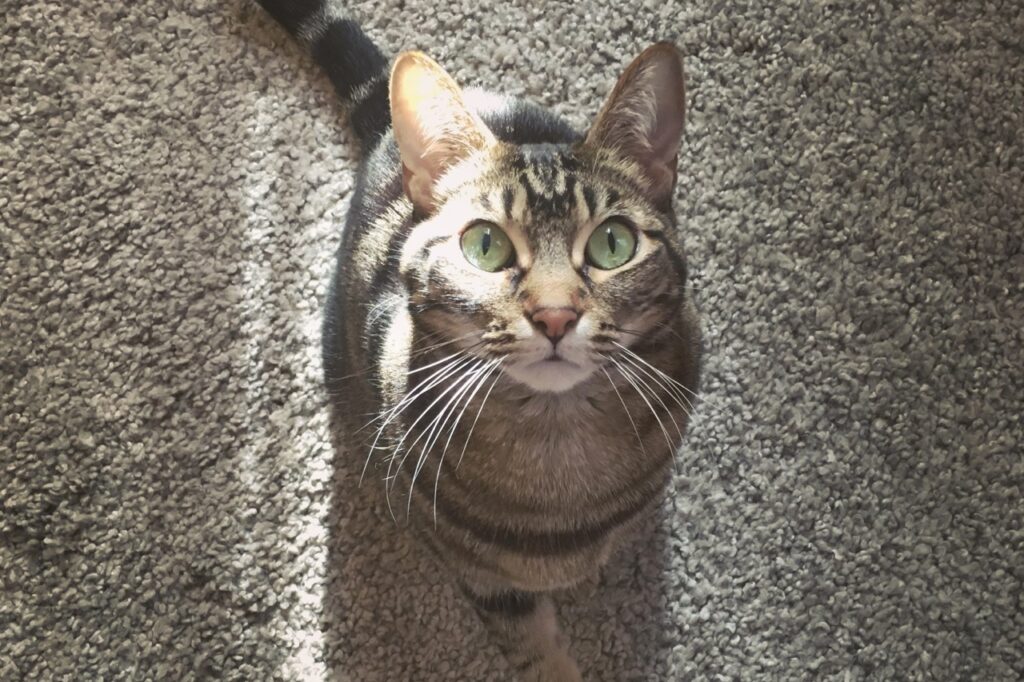Can You Train a Cat? Sure Can. And Here’s Why You Should Train Yours
Ever heard someone say, “You can’t train a cat”? Well, it’s simply not true.
Cats are remarkably intelligent creatures with a natural ability to learn and adapt. And not only can you train your cat, but there are loads of reasons you should.
From strengthening your bond to ensuring safety, the benefits of cat training are as diverse as they are rewarding.
16 Benefits of Training Your Cat
Here’s the TL;DR of why you should train your cat:
- Strengthens your bond with your cat
- Builds your cat’s trust in you
- Helps your cat feel secure and confident
- Makes your cat more likely to be affectionate
- Helps keep your cat safe
- Reduces unwanted behaviors
- Makes grooming and handling easier
- More harmonious relationships with other pets
- Prevents boredom
- Can help your cat be more comfortable around new people
- Promotes cat health and wellbeing
- Your cat learns some cool tricks
- Makes vet visits easier
- Makes giving medications easier when the time comes (and it does for most cats)
- Can make travel with your cat less stressful
- And of course, it’s fun
In the following sections, we’ll explore details of the many reasons why training should be a part of the routine you have with your cat.

A Stronger Bond
Personally, I think the best benefit of training your cat is how it strengthens the bond between the two of you. When you spend time teaching your cat, you’re not just imparting new skills, you’re engaging in active communication.
It may sound trite, but training sessions can truly deepen your connection. As you guide your cat through various commands, you’ll notice a certain look in their eyes—a spark of recognition and partnership.
And of course, as you strengthen your bond, you’re also automatically boosting the trust your cat has in you. By using positive reinforcement training, you show your cat over and over again that interacting with you leads to good things. Lots of good things. (Treats, chin rubs, playtime, etc).
A strong bond with your cat is the foundation for all kinds of other things that make for a great pet.
An Easier Time with Vet Visits, Routine Care, and Giving Meds
A trip to the vet’s office is something that many cats, along with their owners, often dread. Training your cat to associate the pet carrier and being in the car with positive experiences can make car travel much less of an ordeal.
Routine care activities like grooming, brushing and nail trimming can also be stressful. But with training, they can become bonding experiences instead of a battle. Two of my cats actually purr when I trim their claws.
Finally, many people are unaware of the challenges of administering medications to a cat until the day comes where it’s actually necessary. And that is the day they wish they could go back in time and train their cat for it!
Most cats will need to take meds at some point in their lives.
Trust us, it is sooo much easier to administer meds to cats – both oral and topical – when they’re already used to the routine. So train your cat for it at a young age and save yourself the stress of suddenly having to force a sick cat to swallow pills.
Greater Safety
Imagine being able to call your cat away from a risky situation with a simple command. How about minimizing or eliminating door dashing? These things can also be trained.
And let’s not forget safe handling. By training your cat to accept handling, you’re reducing the risk of injury to both your cat and anyone who might need to pick them up.
Mental Stimulation and Behavioral Enrichment
A bored cat can be a recipe for trouble.
Without enough mental stimulation, your clever kitty might find unique ways to stay entertained. Such as using your favorite couch as a scratching post. Or pushing things off the shelf just to watch them fall.
Training can keep a cat’s brain buzzing and engaged, channeling energy into positive behaviors. Training sessions are like puzzles for your cat’s brain.
Physical Health and Well-being
Mental stimulation isn’t just about preventing bad behavior; it’s about promoting overall well-being.
Cats need to play, especially indoor-only cats, and training is perfect for meeting this need.
Regularly trained cats are often more confident and content. An active cat is a healthier and happier cat.
Addressing and Preventing Behavioral Issues
Behaviors like scratching the furniture and jumping on countertops can be really frustrating. But like we mentioned earlier, training can help manage common issues by channeling natural behaviors into appropriate outlets.
By using positive reinforcement during training, you can teach your kitty where it’s okay to scratch. Plus, a well-timed training session can help burn off some of that excess energy that leads to nighttime antics and costs you sleep.
Consistent training can also prevent future issues from cropping up. By setting clear boundaries and expectations through training, your cat will learn what earns them praise and treats, and what doesn’t. It’s a proactive approach to shaping the behaviors you want to see.
Socialization and Adaptability
Proper socialization training can help your cat feel more at ease around new people and other pets, reducing stress and fostering a well-rounded temperament.
Plus, a well-socialized cat is less likely to exhibit fear-based behaviors.
Introducing your cat to a variety of people, pets, and environments at a young age can set the stage for a more adaptable and easygoing adult cat. Progress can still be made with an adult cat, but the gains will probably be more modest.
The Fun of Trick Training
Who says dogs should have all the fun with tricks? Your cat is just as capable. Trick training is not only fun, but it also really enhances the connection you have with your cat, just like with other training.
You can start with simple tricks like ‘sit’ or ‘high-five,’ and work up to more complex tricks like ‘fetch’ or jumping onto your shoulders on command. Trick training is a great way to show off your cat’s intelligence and your bond.
I’ve trained Gandalf and Phoebe to stand up on their hind legs before receiving their food.
Last Meows
Cat training is more than just teaching commands or impressing friends with funny tricks – it’s about enriching your cat’s life and strengthening the special bond you share. Make it a part of your routine and you will be rewarded with a pet that is even more wonderful than they already were.
So what will you teach your cat?
